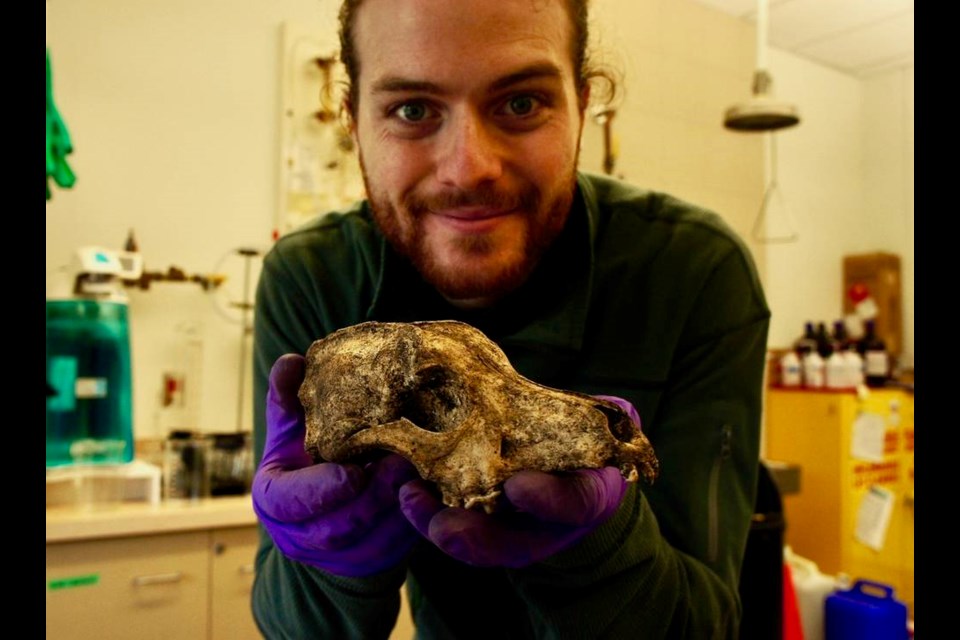A breed of dog raised and revered by First Nations on the west coast of Vancouver Island was fed a significant diet of marine fish — evidence of the animal’s value and cultural importance, according to new research.
The woolly dog lived with First Nations in coastal areas of B.C. and Washington for thousands of years and was valued for its hair, used for textiles such as blankets and other regalia and considered a status symbol worn by high-ranking individuals.
An archaeological joint effort in the Broken Group Islands by the University of Victoria and the Tseshaht First Nation, with support from Pacific Rim National Park Reserve, are revealing more about the woolly dog. It was a small breed with long white fur that were often kept on small islands to preserve the breed and avoid mixing with other village canines.
Captain George Vancouver, who landed in Puget Sound in 1792, likened the breed to a larger Pomeranian. It is associated with Asian dog breeds that likely arrived over the prehistoric land bridge with their human companions.
The woolly dog was believed to be extinct by around 1900, as European settlers introduced sheep.
University of Victoria teams have been studying a dog’s remains unearthed from a burial site on Keith Island (Kakmakimilh), an ancient Tseshaht settlement in the Broken Group Islands.
UVic grad student and lead author Dylan Hillis, whose paper was published by Scientific Reports, used isotopic analysis of remains dating back 3,000 years to determine what the dogs ate and how they were treated by their masters. His analysis of the chemical signatures of the bones showed the Tseshaht dogs were eating and possibly being fed significant amounts of anchovy, herring and salmon, Hillis said. “Obviously, the role that humans took was substantial, since dogs were not catching these fast-moving fish on their own.”
In the paper, Hillis and co-authors Denis St. Claire, Eric Guiry of the University of Leicester and UVic professors Iain McKechnie and Chris Darimont give the first specific estimate of ancient dog diets on the B.C. coast.
The study’s co-authors say their research helps increase understanding of humans’ relationships with dogs, early animal husbandry practices and the cultural and economic significance that the woolly dogs had in Tseshaht Territory and other parts of the coast.
St. Claire is an adopted Tseshaht member and project co-director who has worked in partnership with the Tseshaht First Nation for nearly five decades, connecting scholars, students and Indigenous youth with Tseshaht history through archaeology.
He said there are about 170 separate First Nations heritage sites in the Broken Group Islands, providing information about First Nations’ history and way of life.
The study occurs within Nuu-chah-nulth territory on the West Coast. The Tseshaht are their own nation and part of the Nuu-chah-nulth tribal council.
“Tsehaht First Nation is a true partner in this and are actively supporting the field work and engaged in research.”
St. Claire said the demise of the woolly dog likely began when the Hudson’s Bay Company arrived in the mid-1800s with woven wool blankets. “It’s so much easier to receive a blanket that’s already made than to [care for and feed] dogs.”
McKechnie, who mentored Hillis in his study, has been working with St. Claire for 15 years in Tseshaht territory.
McKechnie and colleagues who study dogs recently published a related paper that takes a broad look at domestic dog husbandry across the Northwest Coast and shows southern B.C. was a hot spot for domestic dogs.
He said DNA analysis of the woolly’s origins would be “a next step” for the project.
The woolly is thought to resemble a “spitz” breed, which includes dogs such as the akita, chow chow as well as various huskies and sled dogs, herders and hunters. They often have long, thick fur and pointed ears and muzzles.
McKechnie notes in his paper there are remains of woolly dogs that have been documented be be up to 5,000 years old from Western Vancouver Island.
A pelt of the only specimen of the Salish Woolly is in the Smithsonian Museum of Natural History, collected in 1859.



